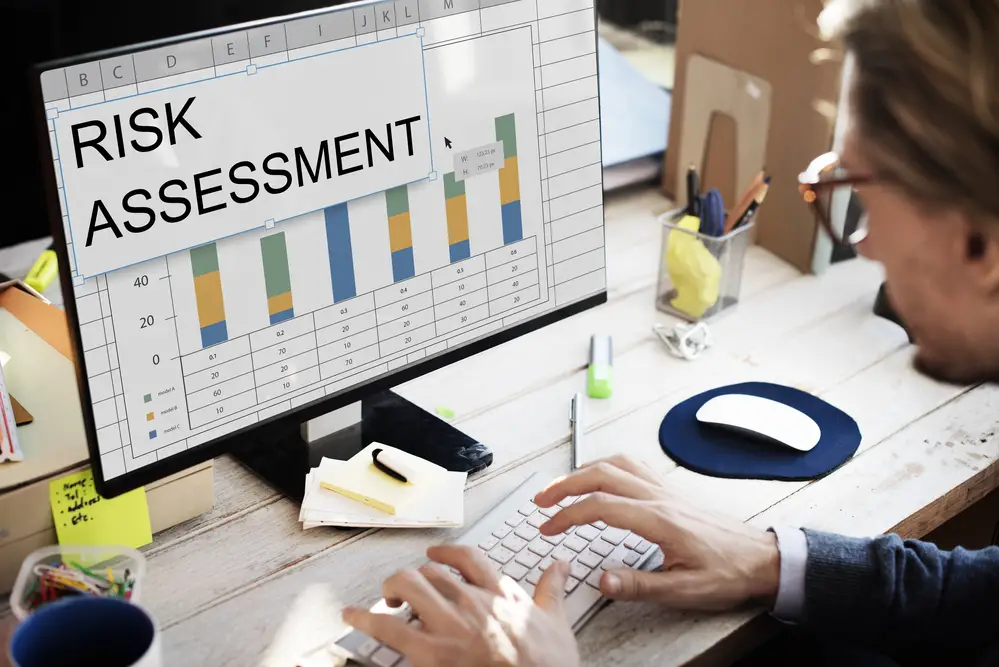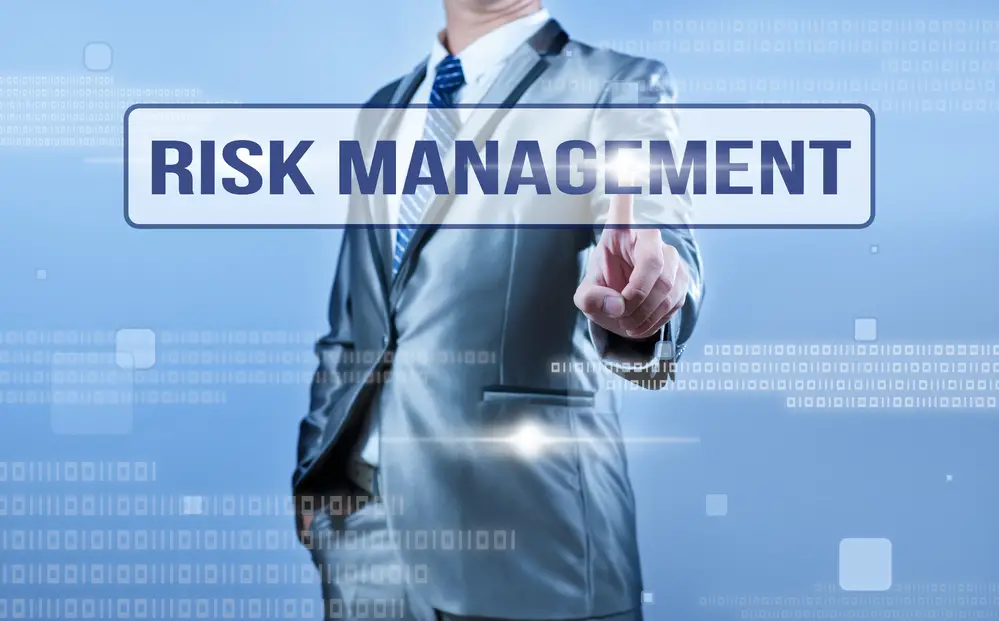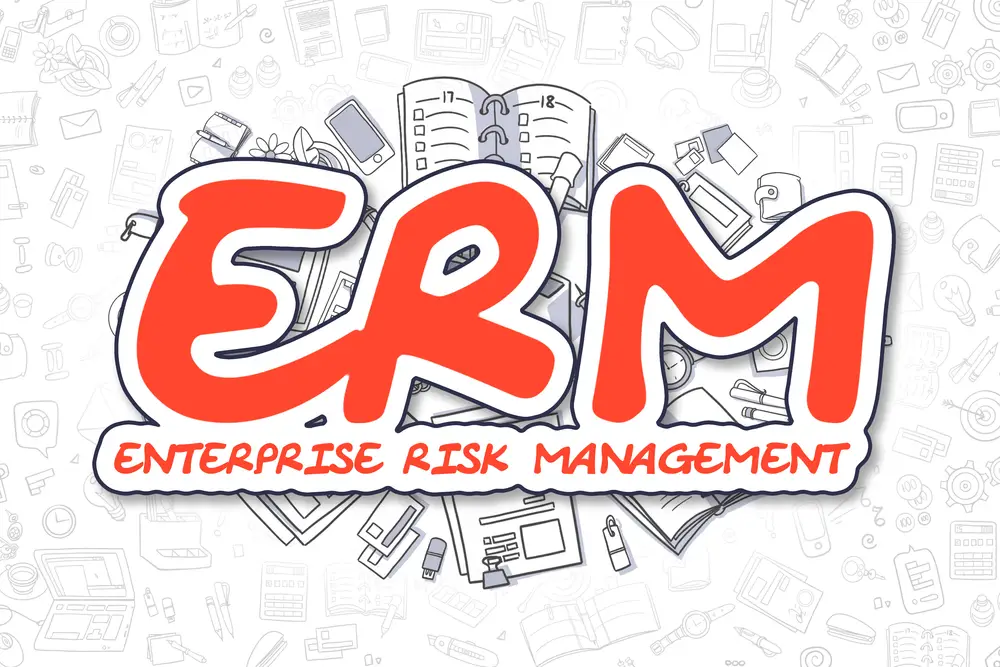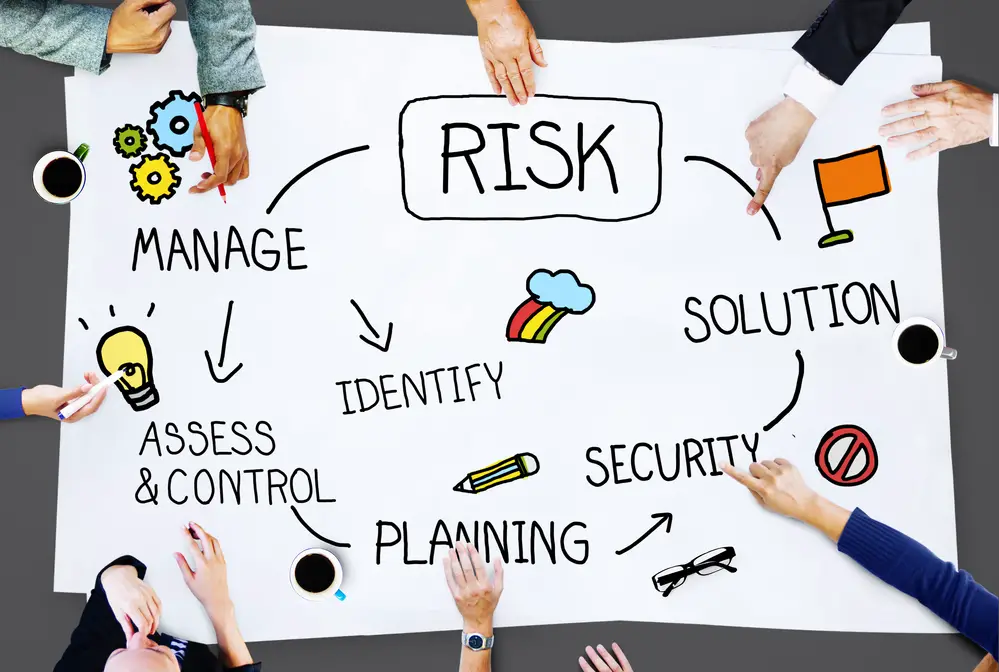An Enterprise Risk Management (ERM) Framework is essential to any organization’s risk management plan. It enables businesses to identify, analyze, and respond to risks associated with operations, processes, and people to mitigate potential losses.According to a 2020 survey by the Risk and Insurance Management Society (RIMS), 73% of respondents reported that their organizations had implemented or were in the process of implementing enterprise risk management (ERM) programs.
Developing a comprehensive ERM framework requires careful thought,planning and the type of risk management strategy. Here are the key steps you should follow to create a successful ERM framework:
1. Establish Objectives
Identify what you hope to achieve by implementing your enterprise risk management framework and set clear objectives for success. This is objective setting strategy setting.
2. Identify Risks
Evaluate potential risks impacting your business operations or bottom line and prioritize them based on severity.
3. Assign Responsibility
Assign responsibility for managing each identified risk to the appropriate person or team within the organization.
4. Design Mitigation Strategies
Create plans to address how each identified risk will be addressed or bypassed to minimize potential damage and losses.
5. Monitor Risks
Regularly monitor your ERM framework for signs of potential risks, re-evaluate existing strategies, and adjust if necessary as your business grows or evolves over time.
An ERP framework consolidating risk management strategies across a whole organization allows for better visibility to the measurement of business goals. Compliance departments can systematically improve compliance governance processes. How does an ERM framework work in the context of business operations?.
Enterprise Risk Management (ERM) is essential for any business that wants to anticipate and mitigate potential losses while taking advantage of new opportunities. Developing an effective ERM Framework allows businesses to identify, analyze, and respond to risks associated with operations, processes, and people.
This blog post provides an introduction to the key steps in developing a comprehensive ERM Framework, so that businesses can remain competitive in today’s fast-paced global market.
Understanding Enterprise Risk Management (ERM)
Enterprise Risk Management (ERM) is a comprehensive approach to managing uncertainty and identifying potential risks associated with various operations, processes, and people. It enables organizations to proactively respond to potential losses while capitalizing on new opportunities for success.
ERM is essential for businesses to remain competitive in today’s fast-paced global market, as it allows them to identify and anticipate possible future risks that could adversely affect their operations or profitability.
Enterprise Risk Management is a kind of process management strategy that aims at identifying risk factors and risks that may cause harm to the operation of business procedures in the context of the business process that may cause them or cause the risk to others.
Culture and practice, integrated into strategy and performance, are used in organizations to manage risk in achieving, maintaining, and creating value.
Integrated Risk Management involves a holistic approach that calls for management decision-making that is unlikely to be appropriate for specialized businesses or segments. Firmwide surveillance is thus taking precedence over individual business units.
This usually includes providing a risk plan of action for everyone in a report. Several sectors, including the construction and energy industries, international development, and financial services, all adopted ERMs. ERM thus enables the company to minimize risks and identify opportunities specific to the firm.
Why is ERM important?
Enterprise Risk Management (ERM) is an increasingly important tool for businesses that want to remain competitive in today’s fast-paced global market. ERM helps organizations anticipate and mitigate potential losses, as well as capitalize on new opportunities for success.
It enables them to identify, analyze, and respond to potential risks associated with operations, processes, and people. Furthermore, ERM systems help businesses stay compliant with current regulations and industry standards. In short, ERM provides a comprehensive approach to managing uncertainty and protecting against potential losses.
Usually, a business focuses primarily on risks. For instance, financial risks impact businesses in an obvious way. The board has a good way of analyzing financial results and sales figures. Cyber security risks are rarely more clear.
CISOs face the complex challenge of converting jargon into accessible executive reports for the enterprise. Cyber risks might seem a little more obvious, but they can influence other forms of risk when realized.

Benefits of an effective ERM program
An effective Enterprise Risk Management (ERM) program offers numerous advantages to businesses. ERM helps organizations anticipate and mitigate potential losses while capitalizing on new opportunities for success.
It enables them to identify, analyze, and respond to potential risks associated with operations, processes, and people. Furthermore, ERM systems help businesses remain compliant with current regulations and industry standards.
Additionally, ERM provides a framework for monitoring and evaluating performance against goals, as well as reporting on key risk indicators. In short, an effective ERM program can provide organizations with peace of mind and reduce the likelihood of financial loss or costly penalties.
The purpose of ERM is to ensure a holistic approach to the organization so that the whole system can align toward one specific goal. Creating a clear understanding of the purpose behind implementing ERM systems is one step toward successful implementation.
A 2008 Deloitte study asked participants to identify the benefits of ERM as compared to how they thought benefits could be experienced. According to the study, respondents believed that ERM could help organizations increase their profitability and provide overall cost savings.
They also stated that ERM would improve decision-making capabilities and reduce risk exposure. Other expected benefits included better transparency, strategic value creation, improved internal control systems, and improved stakeholder trust. Ultimately, the study concluded that an effective ERM program could be instrumental in helping organizations achieve long-term success.
What are the components of an ERM framework?
These include risk assessment and analysis, risk management and control, risk governance, and monitoring and reporting. The first component entails the identification, evaluation, and prioritization of risks.
This helps organizations understand the potential impacts of these risks on their operations and objectives. The second component involves developing strategies and implementing controls that reduce the probability or magnitude of potential losses.
The third component encompasses organizational structures and processes to ensure successful oversight of ERM activities. Finally, the fourth component focuses on ongoing monitoring of risk exposures, as well as reporting results to stakeholders. Taken together, these four components form the basis for an effective ERM program.
According to the COSO book Enterprise Risk Management: Integrating Strategy, a successful ERM framework is composed of five key elements. These elements include internal environment, risk assessment, control activities and information, oversight and communication, and monitoring.
The internal environment element involves setting expectations for risk management from the top levels of an organization. Risk assessment focuses on identifying and assessing potential risks that could affect an organization’s operations and objectives.
Control activities refer to organizational policies and procedures that help manage identified risks. Oversight and communication entails establishing a formal governance structure and effective channels of communication for disseminating relevant information about risks.
Finally, monitoring is essential for regularly evaluating the effectiveness of risk management activities, as well as revising plans when necessary. Through implementing each of these critical components across the organization through a culture of transparency and accountability, companies can effectively prepare themselves to handle any risks they may encounter in the future.
How to choose an ERM Framework?
The first step is to assess your current risk profile and risk appetite which will help you identify the types of risks that need to be managed.
You should also analyze the particular strengths and weaknesses of each potential framework, such as cost, scope, coverage, ease-of-use, and flexibility. Further considerations might include how well a framework integrates with existing processes or systems, the available support options for users of the framework, and the overall culture of risk management within your organization.
In addition, it is important to consider whether a framework provider offers education and training resources to help organizations get up to speed on managing risk. Finally, don’t forget to consult with stakeholders across your organization to help ensure that any selected solution meets everyone’s needs.
There is an extensive range of ERM frameworks available that reflect different factors. For example, health insurance companies must comply with strict regulatory obligations regarding data security and must implement an ERM-related framework which prioritizes reducing cyber risks.

Purpose of an ERM framework.
The purpose of an ERM framework is to provide organizations with a comprehensive risk management system that is tailored to their specific needs and objectives. An ERM framework typically comprises five key components: internal environment, risk assessment, control activities and information, oversight and communication, and monitoring.
Through the internal environment element, leaders establish expectations for managing risks in the organization. Risk assessment helps to identify potential risks affecting operations and objectives. Control activities involve organizational policies and procedures to manage identified risks.
Oversight and communication entails establishing a formal governance structure as well as effective ways of communicating with stakeholders about risks. Finally, monitoring is essential for regularly assessing the effectiveness of risk management activities as well as revising plans when necessary.
Because risks are varied, companies must develop their own procedures to address each. ISO Standard 31000 describes a framework for ERM in terms of integrating design and implementation.
Enterprise Risk Management Frameworks
The Enterprise Risk Managing Framework relays key Risk Assurance Principles. You could also employ ERM frameworks for communication to identify internal and external risks, analyze them or react to them.
The ERM framework provides a structured feedback and support system for businesses implementing the ERM program. The framework provides a standardized risk management culture, regardless of employee turnover and industry standards.
They guide risk management functions and also assist companies in managing complexity, visualizing risk assignments, and defining responsibility for evaluating and analyzing risk control processes and controls.
A holistic approach to risk management
Modern business faces numerous dangers. Historically businesses dealt with risks in a way in which each department managed a different business. Business risk management requires corporations to know their risk exposures and mitigate them.
Besides that, they can choose risk management strategies. Rather than being siloed by risk, an ERM user can see the larger picture. The ERM sees every business unit within its portfolio and seeks to determine the ways in which risks to business units are interrelated and overlap. It can also detect potential risks not known by any one individual unit.
Types of Enterprise Risk Management Frameworks
You need to determine a strategy framework that will fit within the context of the industry you are operating in, your company objectives, organizational structures, technology infrastructure, and available resources.
Certain frameworks may work better for small enterprises, while others provide customized scenarios for the needs of a company. There are dozens of other frameworks that are aimed at managing enterprise risks, such as financial institutions, banking, and healthcare organizations. It is also possible to use them for building your own ERM Framework.
The COBIT ERM Framework
COBIT (2019) is a software governance platform developed by Information Systems Audit Control Association (ISACA).Concept frameworks are widely adopted for managing risks in digitally-encouraged enterprise environments.
COBIT provides a risk management model for a large enterprise business capability and a model tailored for small to medium businesses. Management of information security risks has been simplified and integrated into every aspect of modern businesses through the integration of technologies.
The COSO ERM integrated framework
COSO sponsoring organizations released a revised ERM Framework for Managing enterprise risk and performance to address the role of ERM in strategic enterprise plans and performance. This updated version reflects an increasingly complex business environment.
Founded and developed by five private sector organizations, the COSO aims to provide innovative solutions by establishing a comprehensive framework for business risk management, internal control, and fraud prevention. The group includes the COSO Private Sector Advisory Group.
It is designed to help organizations make strategic decisions by considering the interplay between their enterprise risk management and internal control system. Furthermore, it takes into account the impact of external factors on their environment and helps organizations devise robust risk responses that address various threats.
This framework has been credited for its flexibility to changing conditions and for its easily understandable language when communicating risks across an organization.
The COSO ERM integrated framework can be complex to implement and requires significant resources, including personnel and financial investments. Moreover, due to its broad scope of risk management, this framework may not provide sufficient specificity for organizations to accurately identify potential risks in their operations.
Additionally, the effectiveness of this framework is largely reliant on the organization’s ability to have a clear understanding of its objectives and initiatives. Lastly, risk responses recommended by this framework may lead to conflicts with existing business structures and processes.
ISO 31000 ERM Framework
The ISO 31000:2018 ERM Framework is a cyclical risk management process that integrates, designs, implements, evaluates, and improves the ERM Process. ISO 31000 models are reviewed five times a decade to reflect market evolution and changes in business complexity.
It focuses on a variety of risks allowing organizations to adapt to varying sizes of sectors. For details on ISO 31000: matrix checks list registration and template download.
The ISO 31000 ERM Framework provides a globally applicable standard for organizations to effectively identify, assess, manage and mitigate their risks. This framework takes into account the need for businesses to remain competitive in a modern business environment.
Additionally, it has been credited for its contribution to enhancing governance structures and performance management systems. Furthermore, this framework can help organizations comply with legal requirements and anticipate regulatory changes while simultaneously creating opportunities for innovation.
Lastly, it provides organizations with clear guidelines on recognizing risk-reward relationships that can be beneficial in mitigating financial risks.
The ISO 31000 ERM Framework can come with significant costs related to its implementation. Additionally, since this framework is relatively new, there may be challenges in interpreting and synthesizing its guidance into an organization’s existing risk management strategy.
Moreover, some of the guidance provided by this framework may be open to interpretation, making it difficult for organizations to accurately apply it. Furthermore, this framework may not provide adequate detail or specificity that would enable organizations to effectively identify and address their specific risks. Lastly, the guidance provided by this framework may require significant resources to maintain compliance over time.
The Casualty Actuarial Society (CAS) ERM Framework
The Casualty Actuarial Society is an international accreditation organization. The company focuses entirely on property and reinsurance risk and financial risk. The Canadian Institute for the Management of Risk (CIMS) sponsors an online resource for ERM and risk managers.
The committee organized the ERM framework according to risk types and follows a sequential risk management procedure. There are four types of risk: the risk management process consists of six steps.
The NIST ERM Framework
The National Institutes of Standards and Technological Sciences are governmental institutions of the United States Commerce Department. The NIST framework is a cybersecurity tool for private enterprises that operate within the US government.
The Framework Model for the NIST focuses on identifying and guiding the use of business drivers in cybersecurity operations.
The NIST ERM Framework provides a comprehensive approach to enterprise risk management that takes into account the need to identify, assess and manage risk from various sources. This framework also supports organizations in their efforts to identify areas of potential improvement, enabling them to make data-driven decisions about how to allocate resources.
Additionally, this framework can help organizations comply with statutory requirements while helping them become more resilient in the face of rapidly changing business conditions.
Moreover, it establishes clear guidance on how risks should be identified, assessed, monitored and managed. Lastly, this framework helps organizations recognize risk-reward relationships that can be beneficial when considering mitigation strategies.
The NIST ERM Framework may be demanding on resources since it requires significant planning and preparation. Additionally, since this framework is relatively new, organizations may face a challenge in interpreting and synthesizing its guidance into their existing risk management strategies.
Furthermore, the complexity of some of the components of this framework could lead to confusion or disputes amongst teams or stakeholders. Moreover, the guidance provided by this framework may not provide adequate detail or specificity that would enable organizations to effectively identify and address their specific risks.
Lastly, the maintenance and upkeep of this framework can become burdensome for organizations if they do not invest in necessary resources.
5 interrelated components of COSO ERM Framework
It is updated as a framework that includes five interrelated enterprise risks. This package includes 21 principles covering practice from governance to monitoring, regardless of company size, industry, or type of organization.
RIMS Risk Maturity Model ERM Framework
Risk maturity model (RMM) an ERM-based risk management model aimed to assess the performance and effectiveness of organizations in assessing risk in the industry. It includes 25 competency driver criteria for seven critical ERM attributes.
The RIMS Risk Maturity Model ERM Framework provides a comprehensive approach to risk management that emphasizes continuous improvement and sustainable results. It offers guidance on activities, processes, and leadership capabilities necessary to build an effective enterprise-wide risk management program.
Additionally, this framework allows organizations to establish the right culture and governance structures needed to support a successful risk management strategy.
Furthermore, this framework can help organizations identify where their current risk management posture lies in order to determine areas of improvement and prioritize activities accordingly.
Moreover, it establishes criteria for assessing the level of maturity of an organization’s risk management efforts and also provides benchmarks for comparison. Lastly, its use of performance indicators helps ensure that risks are being managed effectively in an ever-changing business environment.
The RIMS Risk Maturity Model ERM Framework requires significant planning and resources in order to be successfully implemented. Additionally, it is often difficult to accurately assess the risk maturity level of an organization due to a lack of data or limited access to the necessary information.
Furthermore, there is no one-size-fits-all approach that can be used, so organizations must tailor their risk management program specifically for their needs. Moreover, some organizations may find that this framework does not provide sufficient detail for all elements or processes of risk management. Lastly, this framework is still relatively new and may not include the most up-to-date best practices in risk management.

7 attributes of RIMS ERM Framework
The RMM Framework identifies seven key traits for evaluating eRM competence. The RIMS RMM framework is flexible and is suitable for customized ERM frameworks, which are based on the ISO 311000:2018 standard.
How do I develop a customized enterprise risk management framework?
Developing a customized ERM framework requires careful consideration and planning. First, it is important to analyze your company’s risk profile in order to identify potential risks that need to be addressed. This entails gathering relevant information and data, such as industry trends and regulations, organizational objectives, financial performance, and current policies and procedures.
Once you have identified these risks, you can develop an effective risk management plan by creating policies and procedures tailored specifically to address those risks. Additionally, you may want to include practices for monitoring progress; controlling access to resources; documenting processes;
Training employees on proper risk management strategies; conducting periodic reviews of the program’s effectiveness; and reporting any incidents or losses. Finally, regularly evaluate the framework and make adjustments if necessary in order to ensure that your organization remains at the forefront of risk management best practices.
Develop customized ERM-based frameworks to help develop risk management strategies align business goals, and encourage risk-based decision-making. Nevertheless, customizing the ERM framework should not be overwhelming.
The following roadmap to develop a Custom ERM framework is based upon existing management and operations risk frameworks and ERM model inputs. Developing ERM programs can be achieved by following the detailed steps described below.
ERM Framework Stage One: Build a Cross-Functional ERM Team
Select the members of various businesses and the management to serve on the ERM steering committee. The effective implementation of an ERM framework requires support from the highest levels of management, including Executive Director, Senior Managers and Boards. Build a cross-functional ERM group for increasing operational involvement at multiple levels and influencing culture.
ERM team members establish business objectives and develop corresponding risk profiles or RASs to address threats and opportunities in their expertise. First question:
ERM Framework Stage Two: Identify Risks
Know risks – internal and external threats and opportunities resulting in uncertainty and influencing the business outcomes and the resulting risks and opportunities. You can use your risk assessment and RAS to integrate the strategy to identify risks and identify risks.
The ERM framework serves as a playbook to identify threats to business objectives. Use the book as an introduction to identifying risks and opportunities that lead to desired results. Plan risks from Stage One to Objectives and identifies internal and external risks. Be careful not to neglect the risks perspective of the client.
ERM Framework Stage Three: Evaluate Risk
The Risk Assessment establishes the basis for managing and estimating risk and its probable outcomes. During this stage you will develop a risk assessment framework. Use the risk assessment tool to plan the assessment methodology.
The Risk Assessment Form can assist with the evaluation and establishment of risk controls – this is the main activity of Stage 4 activities.
ERM Framework Stage 4: Treat Risk
Managing risks is a phase of an ERM system. This stage includes the design and implementation of the control environment and the development of a risk mitigation action plan. Risk management is managed by Risk Management.
Give risk owners the roles to identify the best times to respond. Determine what companies have specific responsibility for risk control. Internal controls are specific actions taken by the risk holder to mitigate the risks they face and maximize the opportunities.
ERM Framework Stage Five: Optimize Risk Management
The last stage is optimization of risks. How a person can minimize risk depends on resource availability and overall objective. Consult your ERM requirements to select analytics and reporting software. This shouldn’t affect your ERM framework development.
Monitor ERM programs performance and evaluates their impact on the business process. The iterative loop flows from one level to the next for optimal risk management. Use this information to assess potential opportunities in the program for improving the ERM.
Risk response is an important part of an ERM Framework as it helps organizations respond effectively to risks that have been identified. This can involve devising risk responses, such as avoidance, transference, reduction, or acceptance.
It also involves developing risk management guidelines for each risk response and ensuring these are followed. Strategic risk analysis is another important element of the ERM Framework and requires organizations to look beyond the obvious or immediate risks and identify potential future outcomes or scenarios that may have a significant impact on the organization. Risk identification is the process by which organizations detect and evaluate potential risks to their operations and activities.
Tools for developing custom ERM Framework components
These include risk management software, which can be used to identify and assess potential risks; create policies and procedures; monitor performance; and store related documentation.
Additionally, internal audit services can provide insight into areas of risk exposure, while analytics tools can help identify trends or patterns in data that may lead to risk mitigation strategies.
Finally, organizations should also consider engaging training programs to ensure staff members have the knowledge and skills they need to effectively manage risk.
Create a customized ERM Framework using risk management tools and proven strategies. Incorporate this Risk Management tool into creating custom framework components to satisfy business needs.

Challenges in developing ERM Framework
As risk management practices grow and evolve, so too must the strategies that organizations use to tackle risks of all kinds. This includes considering and accounting for a wide range of procedures, processes and programs.
Elements from different areas such as legal, financial, technological and environmental must be included in the plan for it to be comprehensive and effective. There are also challenges that come with trying to effectively communicate the ERM process to stakeholders in order to ensure everyone understands their role. Others include:-
1. Determining the appropriate level of risk to manage – many organizations struggle with identifying and quantifying risks in a way that allows for proper management prioritization.
2. Defining and agreeing on roles and responsibilities – establishing clear lines of responsibility is critical for ensuring that everyone involved in risk management understands their individual role in the process.
3. Gathering and analyzing data – effectively gathering and analyzing data is essential for making informed decisions about risk mitigation strategies.
4. Communicating risks effectively across the organization – it is important for senior management to be aware of major risks facing the organization, but it is also crucial that all.
Conclusion
Building an effective enterprise risk management (ERM) framework can help protect your company from unexpected events or circumstances that could put its success at risk. The key steps involved in developing this kind of framework include identifying potential risks, developing a response plan for each one, and implementing it across all departments within your company.

Chris Ekai is a Risk Management expert with over 10 years of experience in the field. He has a Master’s(MSc) degree in Risk Management from University of Portsmouth and is a CPA and Finance professional. He currently works as a Content Manager at Risk Publishing, writing about Enterprise Risk Management, Business Continuity Management and Project Management.


